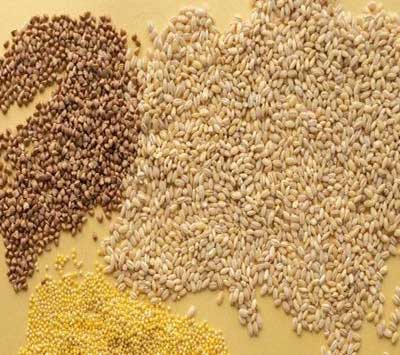Date: 22/03/2023
Relevance: GS-3: Major crops-cropping patterns in various parts of the country, - different types of irrigation and irrigation system storage; issues of buffer stocks and food security.
Key Phrases: Millets, Nutrition, Climate Change, Green Revolution, Exploitation Of Groundwater, Pesticide-Use, Grain Production, Procurement, Food And Agriculture Organization.
Context:
- Millets, a group of coarse grains that serve as a popular staple food, are currently experiencing an unprecedented surge in attention.
Key Highlights:
- The Prime Minister has recently inaugurated a global conference on millets, promoting them as “door to prosperity” for India's marginalized farmers, the “cornerstone of nutrition”, and a potential ally in the fight against "climate change."
- The year 2023 has been declared by the United Nations as the
International Year of Millets.
- In addition, during the budget speech, the Finance Minister highlighted millets as 'Shree Anna,' which roughly translates to 'the best among grains.'
- The Indian Institute of Millets Research in Hyderabad will also receive support as a center of excellence.
- The Green Revolution of the 1960s caused millets, which are considered a 'superfood,' to be overlooked in favor of rice and wheat.
Millets - The Superfood:
- Millets such as sorghum, bajra, and ragi have strong ties to
Indian dietary traditions, which is why India has long been the world's
largest producer of millets.
- As India transitioned into an agricultural society, millets were often relegated to being animal feed.
- However, the country still has around 300 varieties of millets, and in environmentally-conscious times, they have been found to use less water, be heat-resistant, and remain nutrient-dense.
- Moreover, they can absorb a significant amount of carbon dioxide from the atmosphere while releasing oxygen, making them environmentally-resilient and a superfood that can benefit everyone.
Sidelined By The Green Revolution:
- The sidelining of millets, a superfood, by the Green Revolution of the 1960s in favor of rice and wheat had little to do with nutrition and more with the development of high-yielding varieties of rice and wheat that produced two or three times more per acre.
- India's guaranteed procurement coupled with the rice-wheat combination enabled the country to maintain food security even during droughts and climate blights.
- However, this food security came at a cost such as the overuse of groundwater, excessive pesticide use, and outdated systems of grain production and procurement that have become less and less profitable for the average farmer over time.
- In order to compete with the global production of rice, wheat, and maize, which currently accounts for 89% of global cereal production according to the Food and Agriculture Organization, millet production must become significantly more profitable.
Achieving Substantial Growth in Production:
- Despite the existence of hybrid varieties of jowar and bajra, yields have not experienced significant increases in recent decades, indicating that technological advancements alone may not be enough to achieve substantial growth in production.
- To promote millet production and consumption, India should focus on the
following strategies:
- Increase awareness: The government and other stakeholders should focus on educating farmers and consumers about the health and environmental benefits of millets.
- Encourage research and development: The government should
invest in research and development to develop high-yielding,
drought-resistant varieties of millets.
- Additionally, research can also be conducted to develop value-added products made from millets, such as millet-based snacks, breakfast cereals, and gluten-free flour.
- Improve marketing: The government should work on improving marketing channels for millets, making it easier for farmers to sell their produce and for consumers to access millet-based products.
- Provide financial support: The government should provide financial support to farmers who are willing to switch to millet cultivation. This can include providing subsidies, loans, and other financial incentives to promote millet production.
Conclusion:
- Millet is a crop that is both healthy and good for the environment. It was an important part of India's agricultural history until the "green revolution" made high-yielding varieties of rice and wheat more popular.
- However, with rising demand for sustainable agriculture and increased awareness about the health benefits of millets, there is a renewed interest in promoting millets as a global panacea.
- While promoting millets, it is important to avoid promoting certain grains as superior or inferior and instead focus on a more sustainable approach that encourages the production of all grains and helps a wider base of consumers access the cereal they want.
Source: The Hindu
Mains Question:
Q. “How has the Green Revolution impacted the agricultural landscape of India, and what steps is the government taking to promote sustainable agriculture and the production of millets?". Discuss (250 words).







